#ford Kellogg
Text



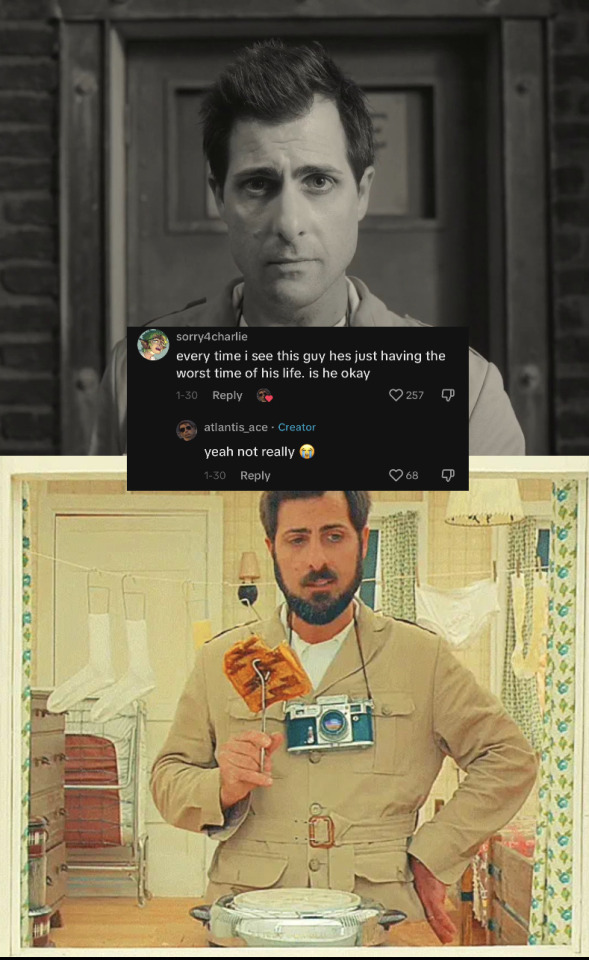
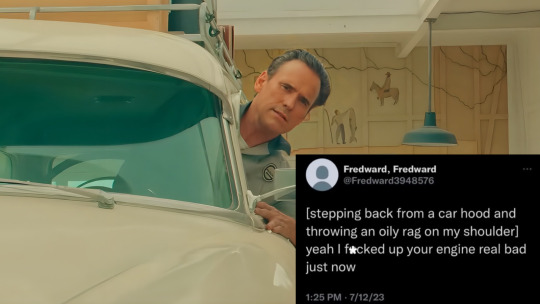



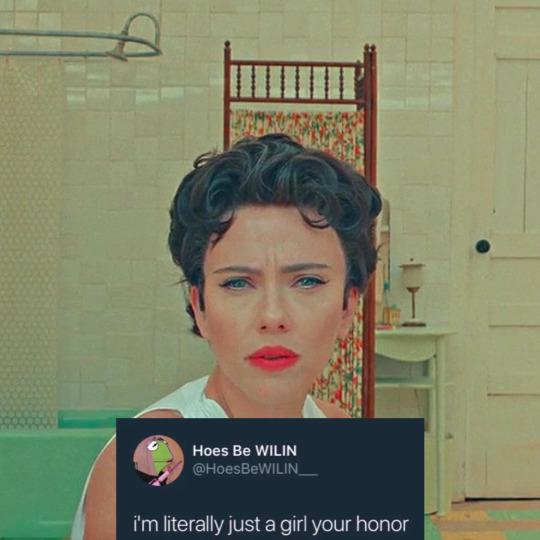
Wes Anderson movies + text post part 3/11 (or until I give up)
Asteroid City edition
#wes anderson#asteroid city#jones hall#augie steenbeck#jason schwartzman#conrad earp#edward norton#schubert green#adrien brody#midge campbell#mercedes ford#scarlett johansson#june douglas#maya hawke#montana#rupert friend#woodrow steenbeck#jake ryan#jj kellogg#liev schreiber#Hank#matt dillon#shut up pretty boy
404 notes
·
View notes
Text
Out of all Fiona's boyfriends, Ford Kellogg's is the one I care for the least. I dunno, I just don't like his overall attitude and personality.
5 notes
·
View notes
Text
a complete boycott list in alphabetical order
a complete list of companies / brands / franchises to boycott in support of palestine that i have been working on putting together for a while now.
remember to support your local businesses
stand with palestine against genocide
(Food & Beverages)
A
Activia
Acqua Panna
Akmina
Absolute Vodka
Algida
A&W
Aquafina
Alpro
Actimel
B
Burger King
Baskin Robbins
Ben & Jerry's
Bugles
Betty Crocker
Badoit
Becel
C
Coca Cola
Costa Coffee
Cadbury
Cheerios
Cheetos
Campbells
Calve
Cappy
Chiquita
D
Dominos
Dasani
Dunkin' Donuts
Doritos
Dr Pepper
Danone
Dolcela
Damla
Dogadan
E
Evian
Eden
F
Fanta
Frito-lay
Fruit by the Foot Roll Ups
Falim
Fresca
G
Gatorade
Greggs
H
Hardees
Haagen Dazs
Heinz Ketchup
Hershey's
Hard Rock Cafe
Heinz
I
Innocent
Israeli Fruits & Vegetables
J
Jacob's
Jaffa
K
KitKat
KFC
Kbueno
Kraft Mac & Cheese
Kellogg's
Kraft
L
Lipton
Lays
M
McDonald's
Mars
Marks & Spencers
Maggi
Marila
Monster
Mountain Dew
Mehadrin
Minute Maid
Milk Bar
M&M's
Magnum Ice Cream
Milka Chocolates
N
Nestle
Nestle Cereals
Nescafe
Nesquik
Nespresso
Nido
Nutella
Nature Valley
Nestle Milo
Nestle Carnation
Nestle Coffee Mate
Nestle Nestum
Nimbooz
Nestea
O
Orea
Original Shredded Wheat
P
Papa John's
Pepsi
Pringles
Pizza Hut
Perrier
Pillsbury
Popeyes
Pretty a Manager
Pure Life
Powerade
Popup Bagels
Q
Quality Street
Quaker
R
Redbull
Ruffles
S
Starbucks
Subway
Smartwater
Sweetgreen
Snickers
Sprite
Sabra
Sunkist
Strauss
Smarties
S.pellegrino
Schweppes
Sana
Sirma
Sara Lee
T
Toblerone
Tang
Twix
Tesco
Tropicana
U
V
Vittle
Volvic
W
Wall's
Walmart
Walkers
Wrigley's
X
Y
Z
7Up
(Clothing)
A
America Eagle
Adidas
Alo
Adina Eden Jewelry
B
C
Converse
Calvin Klein
Cat
Castro
D
Drew
Diesel
E
F
G
Good American
GAP
H
H&M
I
J
K
Kamili
L
Levi's
Lumberjack
M
Mango
N
Nike
O
Oasis
P
Puma
Q
R
River Island
S
Skims
Skinny Dip
St. Mark
Style Nadia
T
Timberland
U
V
Victoria's Secret
Vakko
W
We Wore That
Wyeth
X
Y
Z
Zara
(Beauty)
A
Aveda
Amika
Avon
Aussie
Aveeno
Always
Aesop
Ahava
B
Bobbi Brown
Blistex
Bath & Body Works
Britney Spears Fragrance
Becca
Biotherm
Beauty Blender
C
Clinique
Covergirl
Colgate
Calgon
Camay
CeraVe
Christina Aguilera Perfumes
Clean & Clear
Crest
CND
Cacharel
D
Dr. Jart+
Dove
Dettol
Darphin Paris
Dark & Lovely
E
Essie
Elidor
F
Fenty Beauty
Fair & Lovely
G
Garnier
Gillette
Glam Glow
H
Honest Beauty
Haci Sakir
Herbal Essences
Head & Shoulders
Hugo Boss
I
J
Jo Malone
Johnson & Johnsom
K
Kerastase
Kiehl's
Kylie Cosmetics
Kylie Skin
Kotex
L
L'Oreal
Lacome
La Roche-Posey
Lifebuoy
Lux
Lubiderm
M
Maybelline
MAC
Moroccan Oil
Maui
Matrix
Max Factor
N
Nyx
Neutrogena
Nivea
Nature's Beauty
Niely
O
Olay
Origins
Orkid
Oral-B
Oax
P
Pepsodent
Pantene
Q
R
Revlon
Rimmel
Rexona
Rhode
S
Summer Fridays
Schick
Smashbox
Sephora
Sensodyne
Skinceuticals
Skin Better Science
T
The Body Shop
Too Faced Cosmetics
The Ordinary
Tom Ford Beauty
Tampax
Takami
U
Urban Decay
Ulta Beauty
V
Vichy
Vaseline
Veet
W
X
Y
Yes to
Yuesai
Z
(Luxury)
A
B
C
Chanel
D
E
Estee Lauder
F
G
Georgio Armani
H
I
J
K
L
LVMH
Louis Vuitton
La Mer
Lavs
Le Labo
M
Mugler
Maison Margiela
N
O
P
Prada
Q
R
Raplh Lauren
S
T
Tiffany & Co.
Tom Ford
Tommy Hilfiger
U
V
Valentino
W
X
Y
Yves Saint Laurent
Z
(Tech & Entertainment)
A
Aol
Amazon
AirBnB
Apple
B
BBC
Buxton
Barbie
Booking.com
C
CNN
D
Disney+
Dell
E
Energizer
F
Ford
Fiverr
G
Galaxy
H
HP
Hyundai
Hulu
I
IBM
Intel
J
K
L
Lego
M
Motorola
Movenpick
Mattel
Microsoft
N
National Geographic
Nokia
Netflix
O
Oracle
Oxi
P
Philips
Q
R
Rolls Royce
S
Siemens
Sodastream
T
Toys R Us
U
V
Volvo
Valvoline
W
Wix
X
Y
Z
(Other)
A
Axa
Ariel
Aero
Ambi Pur
Airwick
Aroma
AVC
Amway
Ace Hardware
Andrex
American Express
B
Bounty
Black & Decker
Bonux
Bref
Braun
Benadryl
Band-aid
Barclays
Blue Cross Blue Shield
Better Help
C
Caltex
Chevron
Culligan
Citi Bank
Chicco
Cravola
Clearblue
Capital One
D
Dash
Drynites
Dosmestos
Doona
E
Expedia
F
Finish
Febreeze
Fixodent
Fairy
G
Goop
Gerber
Gys
H
HSBC
Huggies
Hayat
I
Imodium
J
JCB
K
Kimberly-Clark
Kleenex
L
Lion
Little Swimmers
Lenor
M
Mr Muscle
Minidou
Monsanto
N
Nicorette
O
Omo
P
Pampers
Purina Felix
Payoneer
Palmolive
Protex
Pull-ups
P&G
Prima
Pril
Paramount Pictures
Q
R
Rejoice
Rinso
Rogaine
S
Signal
Sensus
Sudafed
T
Tide
U
Unilever
Us Cellular
V
Vim
Vanish
Vicks
W
X
Y
Yumus
Z
(Places)
A
B
C
D
Disney
E
F
G
H
I
J
K
L
M
N
O
P
Q
R
S
T
U
V
W
X
Y
Z
(People)
A
Ashley Tisdale
Amy Schumer
Andy Beshear
B
Bono
Ben Savage
Bella Thorne
Beyonce
C
Chris Evans
Claire Holt
Ciara
Chris Rock
Chris Pine
D
Demi Lovato
Dwayne Johnson
DJ Khaled
E
Eva Longoria
F
G
Gal Gadot
H
I
Ian Somerhalder
J
Jamie Lee Curtis
James Maslow
Justin Bieber
Jennifer Aniston
Jaclyn Hill
Jack Harlow
Jordan Peele
Joseph Quinn
Jack Black
K
Kylie Jenner
Kim Kardashian
Kris Jenner
Kerry Washington
Katie Perry
Karlie Kloss
Khloe Kardashian
Kat Graham
Kendall Jenner
Kourtney Kardashian
L
Lebron James
Lana Condor
Lana Del Rey
M
Millie Bobby Brown
Malala
Mindy Kaling
Mark Hamill
Madonna
N
NFL
Nina Dobrev
Natalie Portman
Nabela
Nicole Richie
Noah Schnapp
O
Octovia Spencer
P
Perez Hilton
Paul Wesley
Phoebe Tonkin
Pia Mia
P!nk
Q
R
Ronaldinho
Rihanna
S
Sofia Richie
Shaquir O'neal
Selena Gomez
T
Tara Strong
Taika Waititi
Taylor Swift
Tyler Perry
U
Usher
U2
V
Vanessa Hudgens
Viola Davis
W
X
Y
Z
#boycott#boycott israel#boycott mcdonalds#boycott starbucks#boycott disney#boycotting#pro palestine#fuck israel#support palestine
72 notes
·
View notes
Text
#i only did boyfriends but im sure ppl have many thoughts#im kinda of confused bc they kinda of all suck in so many ways#she deserved better#fiona gallagher#shameless us#polls#shameless
9 notes
·
View notes
Photo





Visited my family a couple months ago and rediscovered some of my favorite Hot Wheels from childhood! I think the ones from the late ‘70s might’ve been hand-me-downs from older cousins. My nieces & nephew get to play with these now :)
1. Matchbox 33 Willys Street Rod, 1991 (typo on the bottom says "STREEY ROD," came in a box of Kellogg's cereal; source)
2. Hot Wheels Peterbilt truck, 1979
3. Matchbox Nissan 300 ZX, 1990
4. Hot Wheels police car, 1977
5. Matchbox Ford Probe, 1993
19 notes
·
View notes
Text
https://moguldom.com/445821/dr-ray-winbush-and-the-funded-attack-against-lineage-based-reparations-policy-3-things-to-know/?s=09
Dr. Ray Winbush And The Funded Attack Against Lineage-Based Reparations Policy: 3 Things To Know

From L-R) Dr. Raymond Winbush (photo: Morgan State University), Jessica Ann Mitchell Aiwuyor (photo: National Black Cultural Information Trust), Dr. William Darity (Duke University), Kamilah Moore (photo: https://oag.ca.gov/ab3121/members/bios)
Reparations is a heated topic, not just between Black and White Americans but within the Black community as well. When it comes to who should receive reparations, there is a school of thought that it should be given to Black Americans in general. Other reparations scholars, such as Dr. William Darity, Duke University professor in the Sanford School of Public Policy, say reparations should only go to Black people who can trace their ancestry back to a Black slave in America.
Recently, there was a panel discussion featuring pro-reparations advocates, such as Dr. Raymond Winbush, who are against lineage-based reparations. Many of the organizations have ties to major funding. Here are three things to know.
1. Winbush: lineage advocates are like slave catchers
Raymond Winbush compared reparations lineage advocates to “slave catchers.” During the panel discussion, a part of which was posted on Twitter by an account named Non-Human Media, Winbush said people who demanded that reparations go only to those who have shown proof of slave ancestry were like “slave catchers” during slavery who insisted that freed Black people show their papers proving they were not slaves. He added that lineage-based advocates also want to depend on documentation that is created by white people. He added too that lineage-based reparation advocates were “pathologically anti-Pan-African,” meaning they were not advocating for the Black community worldwide.

Pan-African activist Winbush is a research professor and the director of the Institute for Urban Research at Morgan State University. He has also served as a faculty member and administrator at a number of universities, including Oakwood University, Alabama A&M University, Vanderbilt University, and Fisk University.
2. Winbush and funding
Of the people on the panel, which also include Nkechi Taifa (founder, principal and CEO of The Taifa Group LLC, a social enterprise firm whose mission is to advance justice) and Akinyele Umoja (a founding member of the New Afrikan People’s Organization and the Malcolm X Grassroots Movement), Non-Human Media tweeted, “Reminder, these people were given a $500,000 grant from the MacArthur Foundation to “challenge cultural misinformation and disinformation surrounding reparations.”
Dr. Winbush’s research has received funding in the form of grants from the National Science Foundation, Cleveland Foundation, Job Training Partnership Act of 1982, West African Research Association, Pitney Bowes, Inc., the Ford Motor Company, and the Kellogg Foundation, according to his Morgan State University bio.
Also part of the panel discussion of anti-lineage reparations advocates was Jessica Ann Mitchell Aiwuyor, a cultural communications specialist based in Washington, D.C. area. She is the founder of the National Black Cultural Information Trust. According to her bio on the organization’s website, she is a descendant of enslaved Africans and maroons in Georgia and South Carolina.
Additionally, Aiwuyor is a leader and advocate for multicultural digital media. She is the founder of Black Bloggers Connect, the first social network dedicated to supporting Black bloggers around the world, and founder of the Blogger Week Un/Conference, a multicultural social media networking conference held yearly in Washington, DC.
In 2021, the National Black Cultural Information Trust Inc. was awarded a grant from the John D. and Catherine T. MacArthur Foundation for its work to correct cultural disinformation, advance reparatory justice, and share cultural information, stories, and resources that uplift the collective freedom of Black communities, according to a press release.
The grant is part of roughly $80 million in awards MacArthur announced in support of the foundation’s Equitable Recovery initiative, centered on advancing racial and ethnic justice. The initiative is funded by MacArthur’s social bonds, issued in response to the crises of the pandemic and racial inequity.
3. Lineage-based advocates: legally safest route
In a debate that threatens to divide the reparations movement, some advocates want reparations to be distributed based on race, going to all Black people in the U.S. Others, like reparations scholar Dr. William Darity, insist reparations must be based on lineage, paid only to descendants of enslaved people in the U.S.
Reparations based on lineage have a better chance of overcoming political and legal challenges, according to Erwin Chemerinsky, dean of the University of California Berkeley Law School.
Reparations based on lineage, as opposed to race, are less likely to be overturned in court, Berkeley Law School Dean Chemerinsky said during testimony in early March 2022 at one of the commission’s hearings, The New York Times reported.
The historic California Reparations Task Force, chaired by Kamilah Moore, elected to provide reparations based on lineage.
Moore is a reparatory justice scholar and an attorney. She was elected task force chairwoman at the group’s first meeting on June 1, 2021. When the task force opted for a lineage-based route, she said, that not going with a lineage-based approach would “aggrieve the victims of slavery.”
#Dr. Ray Winbush And The Funded Attack Against Lineage-Based Reparations Policy: 3 Things To Know#reparations#Ray Winbush
4 notes
·
View notes
Text
Birthdays 4.7
Beer Birthdays
Charles Duff (1894)
Leo Van Munching Jr. (1926)
Alex Puchner (1961)
Five Favorite Birthdays
Jack Black; actor, singer (1969)
Francis Ford Coppola; film director (1939)
Billie Holiday; singer (1915)
Wayne Rogers; actor (1933)
William Wordsworth; English poet, writer (1770)
Famous Birthdays
Bill Bellamy; actor, comedian (1965)
Jerry Brown; politician (1938)
Irene Castle; dancer (1893)
Jackie Chan; actor, martial artist (1954)
Russell Crowe; actor (1964)
Tony Dorsett; Dallas Cowboys RB (1954)
Allan Dulles; diplomat (1893)
Daniel Ellsberg; "Pentagon Papers" (1931)
Percy Faith; bandleader (1908)
David Frost; television host (1939)
James Garner; actor (1928)
Freddie Hubbard; jazz trumpeter (1938)
Janis Ian; pop singer (1951)
Will Kellogg; cereal maker (1860)
David Low; English cartoonist (1891)
Jennifer Lynch; film director (1968)
John McGraw; New York Giants Mgr (1873)
John Oates; pop singer (1949)
Alan J. Pakula; film director (1928)
Mongo Santamaria; bandleader (1917)
Ravi Shankar; sitarist (1920)
Walter Winchell; journalist (1897)
Stan Winston; special effects artist (1946)
1 note
·
View note
Photo

Ford Capri ’73 (1972-1973) spotted yesterday. #asundaycarpic #makeorangegreatagain #orangeisthenewblack #orangecar #teilixford #FordCapri #fordcaprimk1 #fordcaprigt #caprimk1 #fordcapri1 #ford #capricult #fordcapricult #classicford #vintageford #fordsofinstagram #instaford #fomoco #germanford #germancars #carspotter #classiccarspotting #vintagecarspotting #classiccar #oldtimer #vintagecar #classiccaroftheday #classiccarsdaily #automotivephotography (hier: Kellogg's Bremen) https://www.instagram.com/p/CgY62ZooJA7/?igshid=NGJjMDIxMWI=
#asundaycarpic#makeorangegreatagain#orangeisthenewblack#orangecar#teilixford#fordcapri#fordcaprimk1#fordcaprigt#caprimk1#fordcapri1#ford#capricult#fordcapricult#classicford#vintageford#fordsofinstagram#instaford#fomoco#germanford#germancars#carspotter#classiccarspotting#vintagecarspotting#classiccar#oldtimer#vintagecar#classiccaroftheday#classiccarsdaily#automotivephotography
5 notes
·
View notes
Text
Most work is new work, long-term study of U.S. census data shows
New Post has been published on https://sunalei.org/news/most-work-is-new-work-long-term-study-of-u-s-census-data-shows/
Most work is new work, long-term study of U.S. census data shows
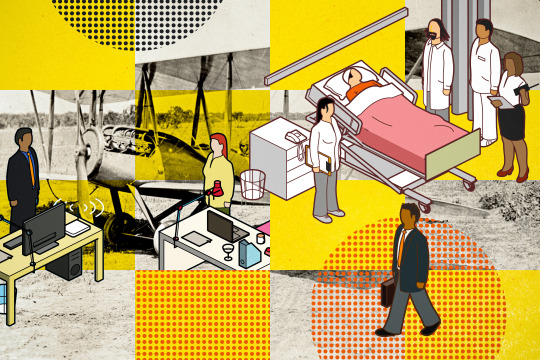
This is part 1 of a two-part MIT News feature examining new job creation in the U.S. since 1940, based on new research from Ford Professor of Economics David Autor. Part 2 is available here.
In 1900, Orville and Wilbur Wright listed their occupations as “Merchant, bicycle” on the U.S. census form. Three years later, they made their famous first airplane flight in Kitty Hawk, North Carolina. So, on the next U.S. census, in 1910, the brothers each called themselves “Inventor, aeroplane.” There weren’t too many of those around at the time, however, and it wasn’t until 1950 that “Airplane designer” became a recognized census category.
Distinctive as their case may be, the story of the Wright brothers tells us something important about employment in the U.S. today. Most work in the U.S. is new work, as U.S. census forms reveal. That is, a majority of jobs are in occupations that have only emerged widely since 1940, according to a major new study of U.S. jobs led by MIT economist David Autor.
“We estimate that about six out of 10 jobs people are doing at present didn’t exist in 1940,” says Autor, co-author of a newly published paper detailing the results. “A lot of the things that we do today, no one was doing at that point. Most contemporary jobs require expertise that didn’t exist back then, and was not relevant at that time.”
This finding, covering the period 1940 to 2018, yields some larger implications. For one thing, many new jobs are created by technology. But not all: Some come from consumer demand, such as health care services jobs for an aging population.
On another front, the research shows a notable divide in recent new-job creation: During the first 40 years of the 1940-2018 period, many new jobs were middle-class manufacturing and clerical jobs, but in the last 40 years, new job creation often involves either highly paid professional work or lower-wage service work.
Finally, the study brings novel data to a tricky question: To what extent does technology create new jobs, and to what extent does it replace jobs?
The paper, “New Frontiers: The Origins and Content of New Work, 1940-2018,” appears in the Quarterly Journal of Economics. The co-authors are Autor, the Ford Professor of Economics at MIT; Caroline Chin, a PhD student in economics at MIT; Anna Salomons, a professor in the School of Economics at Utrecht University; and Bryan Seegmiller SM ’20, PhD ’22, an assistant professor at the Kellogg School of Northwestern University.
“This is the hardest, most in-depth project I’ve ever done in my research career,” Autor adds. “I feel we’ve made progress on things we didn’t know we could make progress on.”
“Technician, fingernail”
To conduct the study, the scholars dug deeply into government data about jobs and patents, using natural language processing techniques that identified related descriptions in patent and census data to link innovations and subsequent job creation. The U.S. Census Bureau tracks the emerging job descriptions that respondents provide — like the ones the Wright brothers wrote down. Each decade’s jobs index lists about 35,000 occupations and 15,000 specialized variants of them.
Many new occupations are straightforwardly the result of new technologies creating new forms of work. For instance, “Engineers of computer applications” was first codified in 1970, “Circuit layout designers” in 1990, and “Solar photovoltaic electrician” made its debut in 2018.
“Many, many forms of expertise are really specific to a technology or a service,” Autor says. “This is quantitatively a big deal.”
He adds: “When we rebuild the electrical grid, we’re going to create new occupations — not just electricians, but the solar equivalent, i.e., solar electricians. Eventually that becomes a specialty. The first objective of our study is to measure [this kind of process]; the second is to show what it responds to and how it occurs; and the third is to show what effect automation has on employment.”
On the second point, however, innovations are not the only way new jobs emerge. The wants and needs of consumers also generate new vocations. As the paper notes, “Tattooers” became a U.S. census job category in 1950, “Hypnotherapists” was codified in 1980, and “Conference planners” in 1990. Also, the date of U.S. Census Bureau codification is not the first time anyone worked in those roles; it is the point at which enough people had those jobs that the bureau recognized the work as a substantial employment category. For instance, “Technician, fingernail” became a category in 2000.
“It’s not just technology that creates new work, it’s new demand,” Autor says. An aging population of baby boomers may be creating new roles for personal health care aides that are only now emerging as plausible job categories.
All told, among “professionals,” essentially specialized white-collar workers, about 74 percent of jobs in the area have been created since 1940. In the category of “health services” — the personal service side of health care, including general health aides, occupational therapy aides, and more — about 85 percent of jobs have emerged in the same time. By contrast, in the realm of manufacturing, that figure is just 46 percent.
Differences by degree
The fact that some areas of employment feature relatively more new jobs than others is one of the major features of the U.S. jobs landscape over the last 80 years. And one of the most striking things about that time period, in terms of jobs, is that it consists of two fairly distinct 40-year periods.
In the first 40 years, from 1940 to about 1980, the U.S. became a singular postwar manufacturing powerhouse, production jobs grew, and middle-income clerical and other office jobs grew up around those industries.
But in the last four decades, manufacturing started receding in the U.S., and automation started eliminating clerical work. From 1980 to the present, there have been two major tracks for new jobs: high-end and specialized professional work, and lower-paying service-sector jobs, of many types. As the authors write in the paper, the U.S. has seen an “overall polarization of occupational structure.”
That corresponds with levels of education. The study finds that employees with at least some college experience are about 25 percent more likely to be working in new occupations than those who possess less than a high school diploma.
“The real concern is for whom the new work has been created,” Autor says. “In the first period, from 1940 to 1980, there’s a lot of work being created for people without college degrees, a lot of clerical work and production work, middle-skill work. In the latter period, it’s bifurcated, with new work for college graduates being more and more in the professions, and new work for noncollege graduates being more and more in services.”
Still, Autor adds, “This could change a lot. We’re in a period of potentially consequential technology transition.”
At the moment, it remains unclear how, and to what extent, evolving technologies such as artificial intelligence will affect the workplace. However, this is also a major issue addressed in the current research study: How much does new technology augment employment, by creating new work and viable jobs, and how much does new technology replace existing jobs, through automation? In their paper, Autor and his colleagues have produced new findings on that topic, which are outlined in part 2 of this MIT News series.
Support for the research was provided, in part, by the Carnegie Corporation; Google; Instituut Gak; the MIT Work of the Future Task Force; Schmidt Futures; the Smith Richardson Foundation; and the Washington Center for Equitable Growth.
0 notes
Text
Most work is new work, long-term study of U.S. census data shows
New Post has been published on https://thedigitalinsider.com/most-work-is-new-work-long-term-study-of-u-s-census-data-shows/
Most work is new work, long-term study of U.S. census data shows


This is part 1 of a two-part MIT News feature examining new job creation in the U.S. since 1940, based on new research from Ford Professor of Economics David Autor. Part 2 is available here.
In 1900, Orville and Wilbur Wright listed their occupations as “Merchant, bicycle” on the U.S. census form. Three years later, they made their famous first airplane flight in Kitty Hawk, North Carolina. So, on the next U.S. census, in 1910, the brothers each called themselves “Inventor, aeroplane.” There weren’t too many of those around at the time, however, and it wasn’t until 1950 that “Airplane designer” became a recognized census category.
Distinctive as their case may be, the story of the Wright brothers tells us something important about employment in the U.S. today. Most work in the U.S. is new work, as U.S. census forms reveal. That is, a majority of jobs are in occupations that have only emerged widely since 1940, according to a major new study of U.S. jobs led by MIT economist David Autor.
“We estimate that about six out of 10 jobs people are doing at present didn’t exist in 1940,” says Autor, co-author of a newly published paper detailing the results. “A lot of the things that we do today, no one was doing at that point. Most contemporary jobs require expertise that didn’t exist back then, and was not relevant at that time.”
This finding, covering the period 1940 to 2018, yields some larger implications. For one thing, many new jobs are created by technology. But not all: Some come from consumer demand, such as health care services jobs for an aging population.
On another front, the research shows a notable divide in recent new-job creation: During the first 40 years of the 1940-2018 period, many new jobs were middle-class manufacturing and clerical jobs, but in the last 40 years, new job creation often involves either highly paid professional work or lower-wage service work.
Finally, the study brings novel data to a tricky question: To what extent does technology create new jobs, and to what extent does it replace jobs?
The paper, “New Frontiers: The Origins and Content of New Work, 1940-2018,” appears in the Quarterly Journal of Economics. The co-authors are Autor, the Ford Professor of Economics at MIT; Caroline Chin, a PhD student in economics at MIT; Anna Salomons, a professor in the School of Economics at Utrecht University; and Bryan Seegmiller SM ’20, PhD ’22, an assistant professor at the Kellogg School of Northwestern University.
“This is the hardest, most in-depth project I’ve ever done in my research career,” Autor adds. “I feel we’ve made progress on things we didn’t know we could make progress on.”
“Technician, fingernail”
To conduct the study, the scholars dug deeply into government data about jobs and patents, using natural language processing techniques that identified related descriptions in patent and census data to link innovations and subsequent job creation. The U.S. Census Bureau tracks the emerging job descriptions that respondents provide — like the ones the Wright brothers wrote down. Each decade’s jobs index lists about 35,000 occupations and 15,000 specialized variants of them.
Many new occupations are straightforwardly the result of new technologies creating new forms of work. For instance, “Engineers of computer applications” was first codified in 1970, “Circuit layout designers” in 1990, and “Solar photovoltaic electrician” made its debut in 2018.
“Many, many forms of expertise are really specific to a technology or a service,” Autor says. “This is quantitatively a big deal.”
He adds: “When we rebuild the electrical grid, we’re going to create new occupations — not just electricians, but the solar equivalent, i.e., solar electricians. Eventually that becomes a specialty. The first objective of our study is to measure [this kind of process]; the second is to show what it responds to and how it occurs; and the third is to show what effect automation has on employment.”
On the second point, however, innovations are not the only way new jobs emerge. The wants and needs of consumers also generate new vocations. As the paper notes, “Tattooers” became a U.S. census job category in 1950, “Hypnotherapists” was codified in 1980, and “Conference planners” in 1990. Also, the date of U.S. Census Bureau codification is not the first time anyone worked in those roles; it is the point at which enough people had those jobs that the bureau recognized the work as a substantial employment category. For instance, “Technician, fingernail” became a category in 2000.
“It’s not just technology that creates new work, it’s new demand,” Autor says. An aging population of baby boomers may be creating new roles for personal health care aides that are only now emerging as plausible job categories.
All told, among “professionals,” essentially specialized white-collar workers, about 74 percent of jobs in the area have been created since 1940. In the category of “health services” — the personal service side of health care, including general health aides, occupational therapy aides, and more — about 85 percent of jobs have emerged in the same time. By contrast, in the realm of manufacturing, that figure is just 46 percent.
Differences by degree
The fact that some areas of employment feature relatively more new jobs than others is one of the major features of the U.S. jobs landscape over the last 80 years. And one of the most striking things about that time period, in terms of jobs, is that it consists of two fairly distinct 40-year periods.
In the first 40 years, from 1940 to about 1980, the U.S. became a singular postwar manufacturing powerhouse, production jobs grew, and middle-income clerical and other office jobs grew up around those industries.
But in the last four decades, manufacturing started receding in the U.S., and automation started eliminating clerical work. From 1980 to the present, there have been two major tracks for new jobs: high-end and specialized professional work, and lower-paying service-sector jobs, of many types. As the authors write in the paper, the U.S. has seen an “overall polarization of occupational structure.”
That corresponds with levels of education. The study finds that employees with at least some college experience are about 25 percent more likely to be working in new occupations than those who possess less than a high school diploma.
“The real concern is for whom the new work has been created,” Autor says. “In the first period, from 1940 to 1980, there’s a lot of work being created for people without college degrees, a lot of clerical work and production work, middle-skill work. In the latter period, it’s bifurcated, with new work for college graduates being more and more in the professions, and new work for noncollege graduates being more and more in services.”
Still, Autor adds, “This could change a lot. We’re in a period of potentially consequential technology transition.”
At the moment, it remains unclear how, and to what extent, evolving technologies such as artificial intelligence will affect the workplace. However, this is also a major issue addressed in the current research study: How much does new technology augment employment, by creating new work and viable jobs, and how much does new technology replace existing jobs, through automation? In their paper, Autor and his colleagues have produced new findings on that topic, which are outlined in part 2 of this MIT News series.
Support for the research was provided, in part, by the Carnegie Corporation; Google; Instituut Gak; the MIT Work of the Future Task Force; Schmidt Futures; the Smith Richardson Foundation; and the Washington Center for Equitable Growth.
#000#aging#applications#artificial#Artificial Intelligence#automation#baby#career#change#college#computer#conference#consumers#content#data#deal#designers#Economics#education#electrical grid#employees#employment#engineers#Features#flight#Ford#form#Forms#Foundation#Future
0 notes
Text
2 Name Brands
Family Businesses
Many businesses are named after their founders? Examples like Duncan Hines, Kellogg’s, or Hewlett-Packard. I think to myself why not my last name. It has a ring to it. Purchasing those other name brands I’m making everybody else richer
Private And Public Foundations
Many foundations are named after their founders’ families, honoring their legacy and contributions. The Ford…
View On WordPress
0 notes
Text
Lucy in Beverly Hills
Part 2 ~ The Episodes
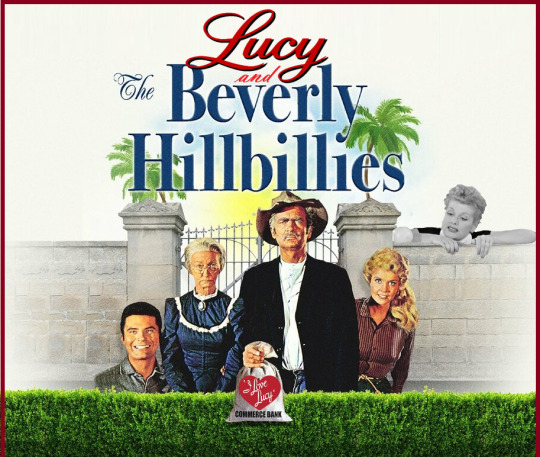
'Thank God I'm doing "Lucy" and thanks for "The Beverly Hillbillies", "Dick Van Dyke", and the rest.' ~ Lucille Ball, November 4, 1963
~ Parallel Universes ~

Sometimes hillbillies turned up on Lucycoms - just not necessarily Beverly Hillbillies. Lucille Ball often blacked out her teeth and deepened her voice to play backwoods type characters.
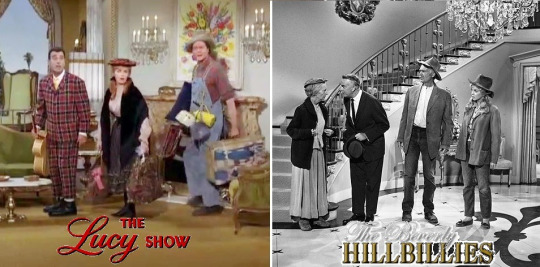
In "Lucy and Tennessee Ernie Ford" Homer (Ernie Ford) and his family walk into a palatial penthouse and “The Lucy Show” suddenly feels very much like an episode of “The Beverly Hillbillies”. It is very likely that “The Lucy Show” cast Roy Roberts as the much-anticipated Mr. Cheever after seeing him play banker Mr. Cushing on "The Beverly Hillbillies". Robert Easton (who plays Iffie on "The Lucy Show") appeared in both the TV series and the 1993 film adaptation of “The Beverly Hillbillies.”

"Turkey Day" (S2;E4) presents what appears to be stereotypical Native American characters (aka "Indians") who are really just actors on a gig. On "Hillbillies" the faux 'Indians' are played by Benny Rubin and George Suwaya, two performers who were also seen on "I Love Lucy." Lucy's "The Indian Show" (1953) featured Ray Kellogg and Frank Gerstle as the pair. in both cases, the 'white' characters (Mrs. Drysdale / Lucy Ricardo) indulge in broken English and use now-offensive terms in a humorous context.
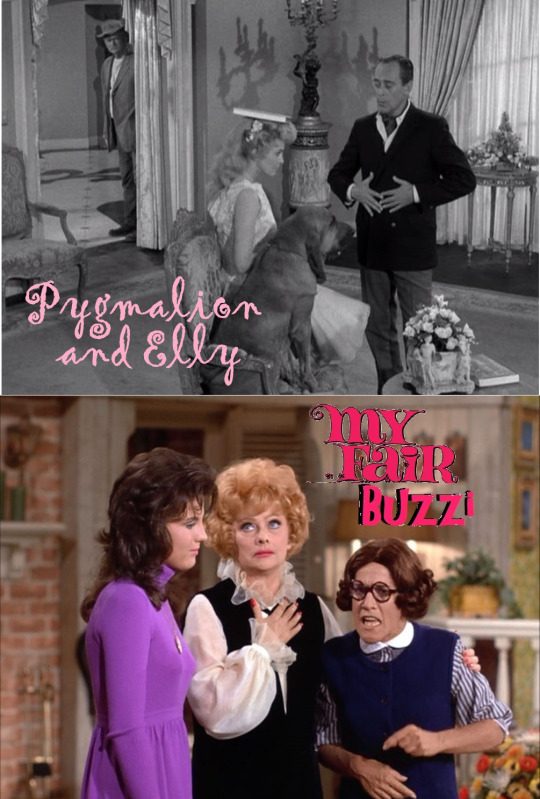
"Pygmalion and Elly" (S1;E10) riffs on the George Bernard Shaw play Pygmalion (filmed in 1938), which was the basis for the 1956 musical My Fair Lady (filmed in 1964). Both play and musical deal with the transformation of a lowly woman into the epitome of beauty and class. In 1962 Sonny Drysdale sets to remake Elly from a hillbilly into a woman of society. In 1972, Lucy transformed wallflower Annie Whipple (Ruth Buzzi) into a brazen showgirl on "Here's Lucy." This was Ball's second take on the story, having previously produced "My Fair Lucy" (1965) on "The Lucy Show."

In 1964, the Hillbillies went on location to Marineland of the Pacific. But they weren't the only only ones. A year later, "The Lucy Show" also shot on location at the marine park, kicking off the show's 'move' to California. CBS had previously shoots at Marineland for “The Munsters”. Coincidentally, Sid Gould, Gary Morton's cousin and a bit player in 45 episodes of “The Lucy Show,” played the Munsters' Marineland tour guide.

"Dog Days" (S6;E27) trots out most all of Frank Inn's canine cast - and then some. Dozens of dogs were also involved in "Lucy and Viv Learn Judo" (1963). Prominent among Elly's pooches is Lord Nelson, the sheep dog who played Mr. Mooney's pet on "The Lucy Show."

1963's "The Clampetts in Court" (S1;E32) finds the family being sued by the Johnsons (Murvyn Vye & Kathleen Freeman) who claim to have been injured in an auto accident caused by Jed. They are faking, of course. In addition to Vye and Freeman, the episode features "Lucy" regulars Roy Roberts and Bert Stevens. Similarly, in a 1972 episode of "Here's Lucy," the Carters find themselves in court when a dancer and his unscrupulous agent (Jim Bates & Jesse White) claim injuries from Lucy's negligence - until Lucy and Harry spy him dancing up a storm with an undercover Kim.
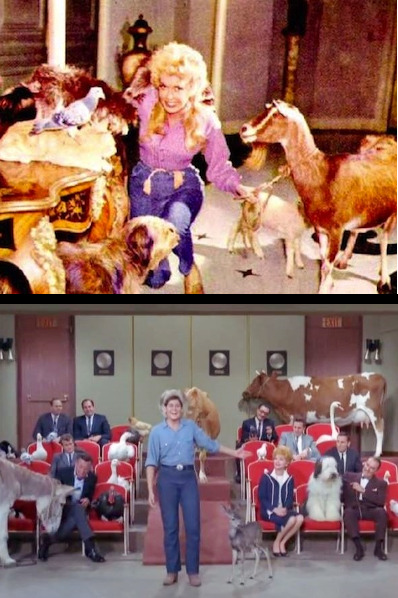
Elly Mae's affection for her 'critters' is not unlike Wayne Newton's on "The Lucy Show" and "Here's Lucy". In both episodes that the singer appears in (as himself), he is surrounded by a variety of barnyard animals. Lucy and Donna Douglas ignored the old show-business axiom: "Never work with children or animals."

"Jed and the Countess" (S3;E26) introduced Jean Willes as the Countess Maria. While she made only one appearance, Countess Henri Gaston Armand Jean-Louis Philippe Framboise Le Cul-de-Sac (aka Rosie Hannigan) played by Ann Sothern made seven appearances on "The Lucy Show" in 1965. Burt Mustin played Countess Maria's chauffeur. Mustin played Old Uncle Joe on two episodes of "The Lucy Show." Countess Framboise flirted with Mr. Mooney the same way Countess Maria flirted with Jed. Willes was seen in two films with Lucille Ball as well as an episode of "Here's Lucy."
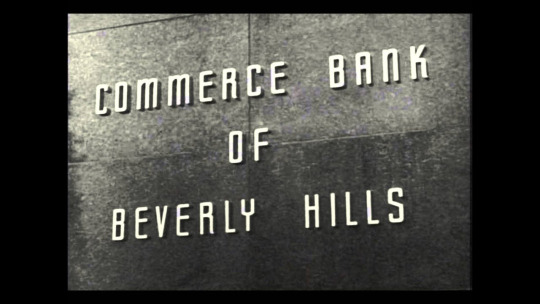
The Commerce Bank of Beverly Hills and The Westland Bank were the banks featured (respectively) on "The Beverly Hillbillies" and "The Lucy Show."
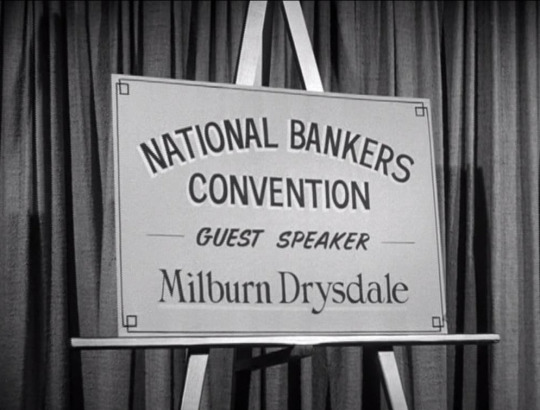
When "Elly Becomes a Secretary" (S1;E35), Millburn Drysdale is guest speaker at the National Bankers Convention. Two years later, in 1964, Vinnie Meyers (Max Showalter) takes over for Mr. Mooney while he is away at a banker's convention in Bridgeport on "The Lucy Show." Meyers is said to be from the Jamestown (NY) branch of Mr. Mooney's bank.
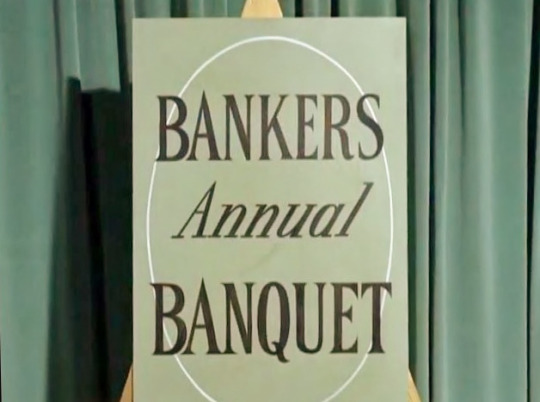
In a 1967 episode of "Here's Lucy," Mrs. Carmichael is volunteered as a date for the 90 year-old president of the bank (Dennis Day) so he can attend the Annual Bankers Banquet. Naturally, she disguises herself as a little old lady and finds that although he is old, he is still very interested in the opposite sex!

"The Clampetts Play the Rams" (S4;E7) tackles two hot topics of the day: Football and Color Television. Lucycoms were no stranger to pigskin plots, the LA Rams in particular. The entire team was featured in the 1949 Lucille Ball film Easy Living. Other mentions include: "The Football Game" (1950), Lucy is a Referee" (1962), "Lucy The Skydiver" (1970), and "Lucy and Aladdin's Lamp" (1971).

Although not played by Stretch (aka Duke), Lucy Ricardo briefly encountered a Basset Hound named Rocky aboard the S.S. Constitution in 1956. Lonely, she briefly considers the dog as a ping pong partner!
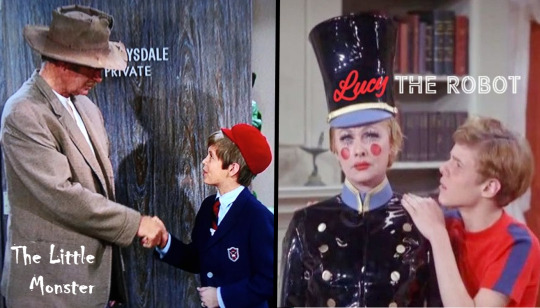
"The Little Monster" (S5;E29) introduces banker Drysdale's obnoxious nephew, Little Millby, played by Teddy Eccles. A year earlier on "The Lucy Show," banker Mooney's unruly nephew Wendell, played by Jay North, visits his uncle Theodore in "Lucy The Robot" (1965). North is best remembered for playing cherubic menace named Dennis on his own sitcom. Coincidentally, Eccles played Arnold Mooney, banker Mooney's youngest son, on a 1964 episode of "The Lucy Show."
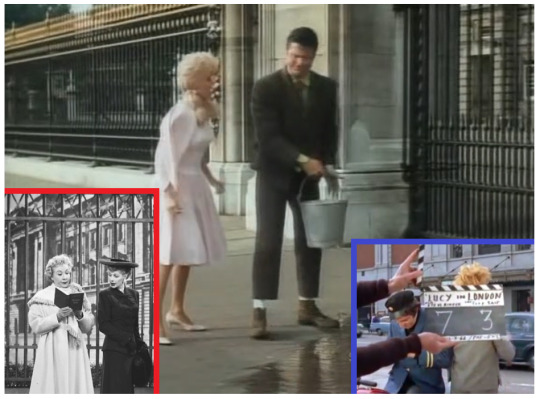
The Clampetts found themselves in England on several occasions. Most of their adventures were filmed in Hollywood, but the shows did include some location shooting with the principal cast, including of Buckingham Palace, a location visited by Lucy and Ethel in 1955. On "I Love Lucy," however, the Palace was recreated at Desilu. In 1966, Lucy Carmichael went to London in a special titled "Lucy in London." This time Ball and company actually visited England. Both the Clampetts and Mrs. Carmichael flew Pan American Airlines. Lucy Carter went to London in 1971 as traveling companion to talk show host David Frost. Once again Pan Am carried the characters across the pond. In return, stock footage of one of their jets was used, but viewers never saw anything more than Hollywood recreations of the interior of the jet and Frost's London TV studio. Faversham!

In "Race for the Queen" (S2;19) in 1964, Miss Jane competed with Elly Mae (and Granny!) for the titled Queen of Beverly Hills. In 1970, Lucy Carter competed with Carol Krausmeyer for the title of Secretary Beautiful. Both pageants featured celebrity judges: Bob Cummings on "Hillbillies" and Robert Alda on "Lucy". Naturally, and somewhat regrettably, both contests included swimsuit competitions!
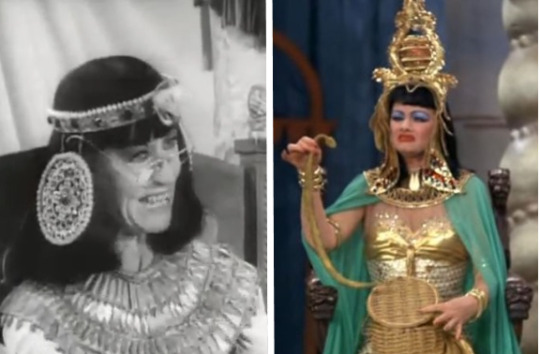
In "Clampett City General Store" (S3;E3) Granny gets cast as Cleopatra in Mammoth Pictures' new epic. A year earlier, in 1963, Lucy Carmichael played Cleopatra for the Danfield Community Players. In both scripts, Theda Bara, who played Cleopatra in 1917, and the 1963 Liz Taylor epic are mentioned. Neither scripts acknowledge the 1934 Cecil B. DeMille epic starring Claudette Colbert.

A bus tour of Beverly Hills is part of "Dr. Jed Clampett" (S3;E5) and a 1955 episode of "I Love Lucy" titled "The Tour". Both feature second unit film footage of a tour bus driving through the palm-lined streets. On the bus, an obnoxious woman is aching to get off, despite the warnings of the bus driver. In "Dr. Jed Clampett", that woman is the mother of a tap dancing prodigy and the home is that of movie studio owner Jed Clampett. In "The Tour," that woman is Lucy Ricardo, and the home is that of movie star Richard Widmark.
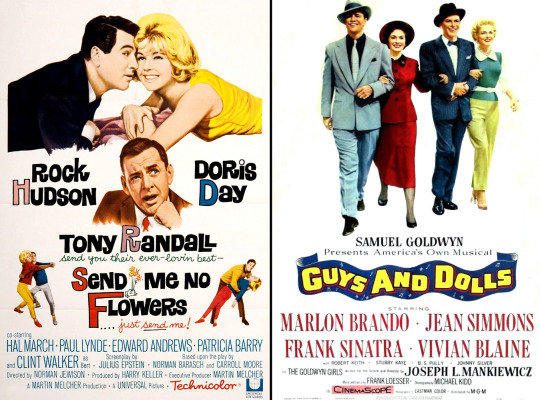
In "Jed the Movie Mogul" (S3;E1), TV viewers (and the Clampetts) get a preview of a scene from the upcoming Universal film Send Me No Flowers. The scene features Rock Hudson and Doris Day and is shown to the Clampetts as dailies from a film being shot at Jed's Mammoth Studios. On a 1955 episode of "I Love Lucy" titled "Lucy and the Dummy" the host of the MGM executive show introduces a clip from their upcoming movie musical Guys and Dolls. After the first airing, the clip was removed from the syndicated print, while Send Me No Flowers remains part of "The Beverly Hillbillies" to this day. That same season, Lucy Ricardo met Rock Hudson on "In Palm Springs." BTW, both films were released in color, but seen on television shows filmed and aired in black and white.
Double Trouble
With so many episodes and so many seasons, it was inevitable that "Hillbillies" and "I Love Lucy" shared the same titles.
"The Ballet" (S3;E10) of the "Beverly Hillbillies" concerns Jed financially rescuing the Los Angeles ballet. Leon Belasco played the ballet master. He was seen on several episodes of "The Lucy Show," often in the context of classical music. "The Ballet" (S1;E10) of "I Love Lucy" has Lucy learning ballet to get into Ricky's act. Mary Wickes played the ballet mistress. Wickes played social climber Adaline Ashley on a 1967 episode of "Hillbillies."
"The Diner" (S6;E19) of "The Beverly Hillbillies" and "The Diner" (S3;E27) of "I Love Lucy" have more than titles in common. They both concern the main characters purchasing a diner. Jethro named his eatery The Happy Gizzard. The feuding Ricardos and Mertzes divide their diner. One half is named A Little Bit of Cuba, and the other side is named A Big Hunk of America.
~ Epilogue: Y'all Come Back Now!

When the Clampetts made the cover of TV Guide in November 1962, it was Lucille Ball who got top billing - with a line over the masthead promoting her TV special with Danny Kaye. "The Beverly Hillbillies" made the cover nine times - while Lucille Ball reigned as queen of the Guide with 39 covers.
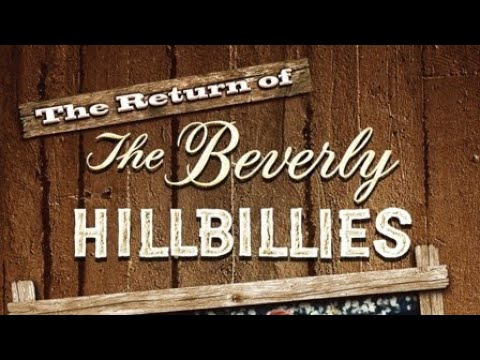
"Return of the Beverly Hillbillies" (1981) featured Lucy regulars Lurene Tuttle as Mollie Heller as Charles Lane as Chief, both of whom were in the original series. Lucille Ball never presented a 'reunion' show as such, she simply reinvented her Lucy character with a new last name, just as she did in 1986's short-lived "Life With Lucy."

In addition to comic books, both shows were novelized for young readers.
#The Beverly Hillbillies#The Lucy Show#I Love Lucy#Here's Lucy#Send Me No Flowers#TV#CBS#Guys and Dolls#Lucille Ball#Vivian Vance#Raymond Bailey#Nancy Kulp#Irene Ryan#Max Baer Jr.#Carol Burnett#Buddy Ebson#Donna Douglas#Frank Inn#Marineland
1 note
·
View note
Text

Detroit is known as the car capital of the world.
Alpena is the home of the world's largest cement plant.
Rogers City boasts the world's largest limestone quarry.
Elsie is the home of the world's largest registered Holstein dairy herd.
Michigan is first in the United States production of peat and magnesium compounds and second in gypsum and iron ore..
Colon is home to the world's largest manufacturer of magic supplies....
The state Capitol with its majestic dome was built in Lansing in l879.
Although Michigan is often called the Wolverine State , there are no longer wolverines in Michigan. (However, one was spotted in 2007, so there are some. )
Michigan ranks first in state boat registrations.
The Packard Motor Car Company in Detroit manufactured the first air-conditioned car in 1939.
The oldest county based on date of incorporation is Wayne in 1815...
Sault Ste. Marie was founded by Father Jacques Marquette in 1668. It is the third oldest remaining settlement in the United States
In 1817, the University of Michigan was the first university established by any of the states. It was founded by priests. Originally named Cathelepistemian and located in Detroit . The name was changed in 1821. The university moved to Ann Arbor in 1841.
The city of Novi was named from its designation as Stagecoach Stop #6 or No.VI.
Michigan State University has the largest single campus student body of any Michigan university. It is the largest institution of higher learning in the state and one of the largest universities in the country. Michigan State University was founded in 1855 as the nation's first land-grant university and served as the prototype for 69 land-grant institutions later established under the Morrill Act of 1862. It was the first institution of higher learning in the nation to teach scientific agriculture..
The largest village in Michigan is Caro.
Michigan's state stone, the Petoskey, is the official state stone. It is found along the shores of Lake Michigan .
The Mackinac Bridge is one of the longest suspension bridges in the world connecting the upper and lower peninsulas of Michigan ..... It spans five miles over the Straits of Mackinac, which is where Lake Michigan and Lake Huron meet. The "Mighty Mac" took three years to complete and was opened to traffic in 1957.
Gerald R Ford grew up in Grand Rapids and became the 38th president of the United States. He attended the University of Michigan where he was a football star. He served on a World War II aircraft carrier and afterward represented Michigan in Congress for 24 years. He was also an Eagle Scout, the highest rank in Boy Scouts.
The Kellogg Company has made Battle Creek the Cereal Capital of the World. The Kellogg brothers accidentally discovered the process for producing flaked cereal products and sparked the beginning of the dry cereal industry.
The painted turtle is Michigan 's state reptile.
The western shore of Michigan has many sand dunes. The Sleeping Bear Dunes rise 460 feet above Lake Michigan .
Living among the dunes is the dwarf lake iris the official state wildflower.
Vernor's ginger ale was created in Detroit and became
the first soda pop made in the United States ..... In 1862, pharmacist James Vernor was trying to create a new beverage when he was called away to serve our country in the Civil War. When he returned, four years later, the drink he had stored in an oak case had acquired a delicious gingery flavor.
The Detroit Zoo was the first zoo in America to feature cageless, open-exhibits that allowed the animals more freedom to roam.
Michigan is the only place in the world with a floating post office.....The J. W. Westcott II is the only boat in the world that delivers mail to ships while they are still underway. They have been operating for 125 years.
Indian River is the home of the largest crucifix in the world. It is called the Cross in the Woods.
Michigan has the longest freshwater shoreline in the world
Michigan has more shoreline than any other state except Alaska .
The Ambassador Bridge was named by Joseph Bower, the person credited with making the bridge a reality, who thought the name, Detroit-Windsor International Bridge , as too long and lacked emotional appeal. Bower wanted to symbolize the visible expression of friendship of two peoples with like ideas and ideals.
Michigan has more than 11,000 inland lakes and more than 36,000 miles of streams.
Michigan has 116 lighthouses and navigational lights. Seul Choix Point Lighthouse in Gulliver has been guiding ships since 1895. The working light also functions as a museum, which houses early 1900's furnishings and maritime artifacts
Forty of the state's 83 counties adjoin at least one of the Great Lakes
Michigan is the only state that touches four of the five Great Lakes .
Standing anywhere in the state a person is within 85 miles of one of the Great Lakes ..
Michigan includes 56,954 square miles of land area, 1,194 square miles of inland waters, and 38,575 square miles of Great Lakes water area.
Sault Ste. Marie was established in 1668 making it the oldest town between the Alleghenies and the Rockies.
Michigan was the first state to provide in its Constitution for the establishment of public libraries.
Michigan was the first state to guarantee every child the right to tax-paid high school education.
Four flags have flown over Michigan - French, English, Spanish and United States .
Isle Royal Park shelters one of the largest moose herds remaining in the United States .....
Some of the longest bulk freight carriers in the world operate on the Great Lakes. Ore carriers 1,000 feet long sail Michigan 's inland seas.
The Upper Michigan Copper Country is the largest commercial deposit of native copper in the world.
The 19 chandeliers in the Capitol in Lansing are one of a kind and designed especially for the building by Tiffany's of New York. Weighing between 800-900 pounds apiece, they are composed of copper, iron, and pewter.
The first auto traffic tunnel built between two nations was the mile-long Detroit-Windsor tunnel under the Detroit River .
The world's first international submarine railway tunnel was opened between Port Huron, Michigan, and Sarnia, Ontario, Canada in 1891.
The nation's first regularly scheduled air passage service began operation between Grand Rapids and Detroit in 1926.
In 1879, Detroit telephone customers were first in the nation to be assigned phone numbers to facilitate handling calls.
In 1929, the Michigan State Police established the first state police radio system in the world..
Grand Rapids is home to the 24-foot Leonardo Da Vinci horse, called Il Gavallo. It is the largest equestrian bronze sculpture in the Western Hemisphere .
The State Motto (written in Latin) translates to: "If you seek a pleasant peninsula, look about you."
0 notes
Link
Check out this listing I just added to my Poshmark closet: Matchbox Kelloggs Raisin Bran Ford Model A Truck 1979 Missing Headlight.
0 notes
Text
UNESCO’s global forum on racism and discrimination.
youtube
Last November, the United Nations Educational, Scientific and Cultural Organization (UNESCO) held its second annual Global Forum against Racism and Discrimination. The forum, in Mexico City, was hosted by the government of Mexico, with support from the W.K. Kellogg Foundation, Ford Foundation, Canada and the Republic of Korea. In 2020, UNESCO had committed to strengthening its contribution to the global fight against racism and discrimination. This year’s theme was “Post-Covid Recovery” – addressing the adverse impacts that racism and discrimination have had on vulnerable populations.
Over the two days at Los Pinos – an estate once reserved for the president of Mexico – more than 90 individuals from across the world spoke as part of more than a dozen panels, ceremonies and side events. Conversations tackled educational, legal, policy, institutional and civil society approaches to fighting racism and discrimination globally.
Among the panelists were representatives of WKKF grantee COPERA, an organization dedicated to raising awareness about racism in Mexico. COPERA coordinator Judith Bautista Pérez served on a panel about the role of civil society and movements in the fight against racism and discrimination. She described ways in which individuals in Mexico can deconstruct racism against Indigenous and Afro-descendant communities on a daily basis, including questioning normalized privileging of certain identities over others. COPERA member Marco Pérez Jiménez, from the University Program for the Study of Cultural Diversity and Interculturality at the National Autonomous University of Mexico, spoke on a panel on anti-Asian racism. He emphasized that a tremendous amount of work remains to be done in labor, academic and educational spheres to combat anti-Asian hate in Latin America.
During the final panel, about approaches for mobilizing resources to combat racial inequity and discrimination, WKKF’s Carla Thompson Payton, vice president for program strategy, spoke about the foundation’s journey to become an anti-racism organization, which includes hard work to change from within, as well as letting communities lead.
“Our role as philanthropy is to step out of the way, leverage the power that we have for our financial resources,” she said, “to ensure that people have a chance to tell their own story, to ask for the things that they want, to demand the things that they want, and to be in a leadership position to make those changes.”
Finally, in the closing ceremony, Thompson Payton delivered a speech highlighting the foundation’s work in Mexico and the Racial Equity 2030 challenge. She introduced representatives of the challenge’s five awardees – ActionAid, Communities United, Indian Law Resource Center, Namati, and Partners in Development Foundation – who were present at the forum and who will be working over the next eight years to apply a total of $80 million to their work toward racial equity around the world.
Thompson Payton also said the Kellogg Foundation is honored to be a sponsor of the event and that the connections made this week could be a vital part of moving the work forward.
youtube
“As you know, racial equity is a core pillar of who we are as an organization and is the fight that we fight every single day on behalf of children, families and communities,” she said. “And we hope that the conversations that you’ve heard this week … are really inspiring you to stay in this fight to do this hard work, to partner with us and with each other to eliminate racism.”
Read More
On COPERA’s past work: Mexicans of African descent are being counted in historic 2020 Census
On Racial Equity 2030: ‘Our children need more than hope’: WKKF’s bold Racial Equity 2030 makes headlines
Watch the first day of the conference: Global Forum against Racism and Discrimination 2022, Day 1
Watch the second day of the conference: Global Forum against Racism and Discrimination 2022, Day 2
0 notes
Text
Top Executive MBA College In India
One of the most popular degrees in the country is the MBA, especially among students who want to work in private sector management. Top Executive MBA Colleges In India was a relatively unfamiliar term to Indians until recently. Today, however, it is one of the most popular courses for executives looking to take their career opportunities to the next level. With at least five years of professional experience, he is an executive of 4,444 businesses he must be enrolled in an executive MBA. Each university has a separate set of work experience requirements. Candidates or students may have full-time employment in addition to enrollment in this program.
Some of the best executive MBA colleges are in India. These include the Indian Institute of Management (IIM) Ahmedabad, Indian Institute of Management (IIM) Calcutta, Kolkata, Faculty of Management (FMS) in Delhi, Indian Institute of Management (IIM) Indore and Kojichod, Institute of India. School of Management (IIM) Kozhikode, Indian Institute of Trade (IIFT Delhi), Institute of Management Technology (IMT) in Ghaziabad, NMIMS Business School.
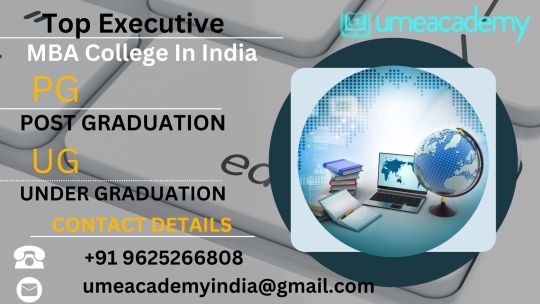
List Of Top Executive MBA Colleges In India
List of some of the top executive MBA colleges in India are as follows:
IIM Ahemdabad
In 1961, the Indian Institute of Management Ahmedabad (IIMA) was established in Ahmedabad. With the support of Dr. Jivraj Mehta, the former Prime Minister of Gujarat was founded by a group of unorthodox people including Dr. Gujarat. Vikram Sarabhai, a space scientist, and Sri Kasturbhai Lalbhai, a famous businessman and philanthropist. To lay the foundation for the Institute, the organization partnered with federal, state, and local governments, as well as the Ford Foundation and Harvard Business School. His company IIMA, incorporated under the Companies Act, oversees the establishment. The European Foundation for Management Development (EFMD) has accredited IIMA as the first management school in the country under the European Quality Improvement System (EQUIS) (EFMD).
Indian School Of Business, Hyderabad
The Indian School of Business (ISB) is located in Hyderabad, Telangana, India. A group of academics and businessmen established the Institute in 2001 with the aim of educating McKinsey & Company senior executives Rajat Gupta and Anil Kumar to high standards. American and Indian businessmen made up the institute's board of directors. ISB's founding institutions are the Wharton School and the Kellogg School of Management at the University of Pennsylvania. One of ISB's partner schools is the London Business School. ISB has offices in Mohali and Hyderabad (Punjab).
The University Grants Commission (UGC) of New Delhi has approved his ISB in Hyderabad. Our triple accreditation of AACSB, Association of MBAs (AMBA), and EFMD Quality Improvement System makes us one of the few selected business schools (EQUIS) in the world. All India Council for Technical Education (AICTE) (New Delhi) has approved the courses offered by the institute.
IIM Bangalore
One of the most prestigious universities for a Master of Business Administration degree is IIM Bangalore. In two years he will continue for more than six semesters. IIMB's impressive faculty consists of more than 140 of his highly qualified academics and researchers dedicated to providing a rewarding educational experience for students. IIMB's Ph.D., MBA, PGPPM, and MBA programs are IIMB's core offerings (business analytics). CAT, GMAT, GRE, NET-JRF, and IIMB test scores are used by the Institute to determine admission to PGP, Executive MBA, and Ph.D. The 2022 CAT registration deadline is September 21, 2022. IIMB offers his two certificate programs, N.S. Ramaswamy Pre-Doctoral Fellowship and Mahatma Gandhi National Fellowship, as well as PGP, EPGP, PGP Enterprise Management (PGPEM), and PGP Public. Ph.D. in Policy Management (PGPPM) and PGP Business Analysis (PGPBA). (MGNF).
IIM Calcutta
IIM Calcutta begins with CAT registration for the 2023 academic year. In the NIRF 2022 rankings, in the management category, he ranks IIM Calcutta his third. IIM Calcutta has placed her seventh batch of his PGDBA students on a summer internship. During the two-day internship placement process, recruiters were grouped into four clusters based on industry: consulting, BFSI, healthcare, and products and services.
Xavier School Of Management
Jamshedpur is home to XLRI, known as the Xavier School of Management. Outlook The 2021 I-Care MBA rankings rank XLRI Jamshedpur as the best private management school in India. In addition to the Jamshedpur campus, XLRI has a campus in the Delhi NCR area, 25 kilometers from Gurugram. PGDBM and PGDHRM programs are available at a total of 360 locations in XLRI Jamshedpur. The XLRI School of Business also offers a 15-month, 120-seat Executive PGDM program.
Top Executive MBA Course List
For working professionals, an Executive MBA college in India is an excellent option. An Executive MBA college degree in India has several specializations. Below are some of the most notable ones.
Operations
Enterprise Analytics
Worldwide Business
Chain of Supply
Finance
human Resources
Marketing and Sales
Systems and IT
Top Executive MBA Admission Process
Based on students' scores on national-level entrance exams. Admission to IIMB's flagship courses (PGP or MBA) is based on valid CAT exam scores followed by the PI-WAT round. The final eligibility criteria for the PGP program have been revised for approval in 2021. This is because the institution lowered her CAT cutoff score for first-level finalists (in each category) to the 5th percentile.
PGP programs accept both domestic and international students
International students applying for admission to PGP must have a valid GMAT score
For EPGP, applicants must have a valid GMAT score. must have
Top Executive MBA Eligibility Criteria
Executive MBA college eligibility c criteria for students is described below. Different management colleges and business schools may have different requirements. This section describes the major requirements that all universities must meet. Let's take a look at the typical requirements for an executive MBA program at a university.
• Candidates must have a Bachelor's degree from an accredited college or university with at least 50% of the required grades.
• A prerequisite of professional experience in an Executive MBA is essential. Applicant must be full-time and have been employed for at least two years. Some universities may take him two years or more to meet this requirement.
• Candidates must be employed at the time of both application and enrollment in the program.
Top Executive MBA Fees
The tuition fee for Executive MBA ranges from Rs.8 lakh to Rs.22 lakh for the duration of the program. Tuition fees can be higher or lower depending on what the institute offers. A similar fee structure exists for both public and private MBA programs. Students of good ability and of low socioeconomic status may also apply for private and publicly funded scholarships.
Conclusion
The top Executive MBA course is very well known and from the above blog the candidates can get a clear picture of all the admission procedures, eligibility criteria, placements, etc. similar to this course and its field. I can do it.
#topexecutivembacollegesinindia#executivembaeligibility#executivembaindelhincr#listsoftopexecutivembaschoolsinindia
0 notes